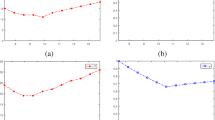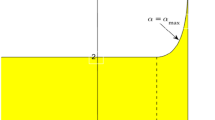Abstract
This paper is concerned with two well-known families of iterative methods for solving the linear and nonlinear complementarity problems. For the linear complementarity problem, we consider the class of matrix splitting methods and establish, under a finiteness assumption on the number of solutions, a necessary and sufficient condition for the convergence of the sequence of iterates produced. A rate of convergence result for this class of methods is also derived under a stability assumption on the limit solution. For the nonlinear complementarity problem, we establish the convergence of the Newton method under the assumption of a “pseudo-regular” solution which generalizes Robinson's concept of a “strongly regular” solution. In both instances, the convergence proofs rely on a common sensitivity result of the linear complementarity problem under perturbation.
Similar content being viewed by others
References
M. Aganagic, “Iterative methods for linear complementarity problems,” Technical Report SOL 78-10, Systems Optimization Laboratory, Department of Operations Research, Stanford University (Stanford, CA, 1978).
J.F. Bonnans, “Rates of convergence of Newton type methods for variational inequalities and nonlinear programming,” Manuscript, INRIA (1990).
R.W. Cottle, J.S. Pang and R.E. Stone,The Linear Complementarity Problem (Academic Press, 1992).
A.R. De Pierro and A.N. Iusem, “Convergence properties of iterative methods for symmetric positive semidefinite linear complementarity problems,” Technical Report, Instituto de Matemática Pura e Aplicada (Rio de Janeiro, Brazil, 1990).
M.S. Gowda and J.S. Pang, “On solution stability of the linear complementarity problem,”Mathematics of Operations Research, forthcoming.
C.D. Ha, “Stability of the linear complementarity problem at a solution,”Mathematical Programming 31 (1985) 327–332.
P.T. Harker and J.S. Pang, “Finite-dimensional variational inequality and nonlinear complementarity problems: A survey of theory, algorithms and applications,”Mathematical Programming 48 (1990) 161–220.
A.J. Hoffman, “On approximate solutions of systems of linear inequalities,”Journal of Research of the Nationai Bureau of Standards 49 (1952) 263–265.
A.N. Iusem, “On the convergence of iterative methods for symmetric linear complementarity problems,” Technical Report, Instituto de Matemática Pura e Aplicada (Rio de Janeiro, Brazil, 1990).
N.H. Josephy, “Newton's method for generalized equations,” Technical summary report 1965, Mathematics Research Center, University of Wisconsin (Madison, WI, 1979).
A. Ostrowski,Solution of Equations and Systems of Equations (Academic Press, New York, 1966, 2nd ed.).
Y.Y. Lin and J.S. Pang, “Iterative methods for large, convex quadratic programs: A survey,”SIAM Journal on Control and Optimization 25 (1987) 383–411.
Z.Q. Luo and P. Tseng, “On the convergence of a matrix splitting algorithm for the symmetric monotone linear complementarity problem,”SIAM Journal on Control and Optimization 29 (1991) 1037–1060.
Z.Q. Luo and P. Tseng, “On the linear convergence of descent methods for convex essentially smooth minimization,” Technical Report LIDS-P-1979, Laboratory for Information and Decision Systems, Massachusetts Institute of Technology (Cambridge, MA, 1990).
O.L. Mangasarian, “Solution of symmetric linear complementarity problems by iterative methods,”Journal of Optimization Theory and Applications 22 (1977) 465–485.
O.L. Mangasarian, “Locally unique solutions of quadratic programs, linear and nonlinear complementarity problems,”Mathematical Programming 19 (1980) 200–212.
O.L. Mangasarian, “Convergence of iterates of an inexact matrix splitting algorithm for the symmetric monotone linear complementarity problem,”SIAM Journal on Optimization 1 (1990) 114–122.
O.L. Mangasarian and T.H. Shiau, “Lipschitz continuity of solutions of linear inequalities, programs and complementarity problems,”SIAM Journal on Control and Optimization 25 (1987) 583–595.
J.S. Pang, “On the convergence of a basic iterative method for the implicit complementarity problem,”Journal of Optimization Theory and Applications 37 (1982) 149–162.
J.S. Pang, “Necessary and sufficient conditions for the convergence of iterative methods for the linear complementarity problem,”Journal of Optimization Theory and Applications 42 (1984) 1–17.
J.S. Pang, “More results on the convergence of iterative methods for the symmetric linear complementarity problem,”Journal of Optimization Theory and Applications 49 (1986) 107–134.
J.S. Pang, “Solution differentiability and continuation of Newton's method for variational inequality problems over polyhedral sets,”Journal of Optimization Theory and Applications 66 (1990) 121–135.
S.M. Robinson, “Strongly regular generalized equations,”Mathematics of Operations Research 5 (1980) 43–62.
S.M. Robinson, “Some continuity properties of polyhedral multifunctions,”Mathematical Programming Study 14 (1981) 206–214.
P. Tseng and Z.Q. Luo, “Error bound and convergence analysis of matrix splitting algorithms for the affine variational inequality problem,” Technical Report LIDS-P-1988, Laboratory for Information and Decision Systems, Massachusetts Institute of Technology (Cambridge, MA, 1990).
D.W. Walkup and R.J.-B. Wets, “A Lipschitzian characterization of convex polyhdera,”Proceedings of the American Mathematical Society 20 (1969) 167–173.
Author information
Authors and Affiliations
Additional information
This work was based on research supported by the National Science Foundation under grant ECS-8717968.
Rights and permissions
About this article
Cite this article
Pang, JS. Convergence of splitting and Newton methods for complementarity problems: An application of some sensitivity results. Mathematical Programming 58, 149–160 (1993). https://doi.org/10.1007/BF01581264
Received:
Revised:
Issue Date:
DOI: https://doi.org/10.1007/BF01581264




